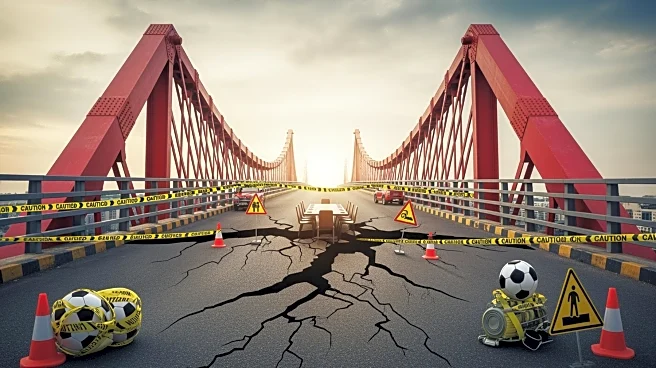What's Happening?
The Hongqi Bridge in China's Sichuan province collapsed just months after its opening, following warnings about cracks and shifting ground. The 758-meter-long bridge, part of a national highway linking China's interior to Tibet, was closed after police
noticed cracks forming on nearby slopes and roads. The situation worsened with landslides causing the collapse of the bridge's approach and roadbed. No injuries were reported, but the incident is a significant embarrassment for the state-backed contractor, Sichuan Road & Bridge Group. The collapse highlights ongoing safety concerns related to infrastructure expansion in China's mountainous regions, where unstable terrain and rushed construction timelines pose risks.
Why It's Important?
The collapse of the Hongqi Bridge underscores the challenges and risks associated with rapid infrastructure development in China, particularly in geologically unstable areas. It raises questions about construction standards and safety protocols, potentially impacting public trust in infrastructure projects. The incident may prompt a reevaluation of construction practices and regulatory oversight, influencing future projects and policies. Additionally, the collapse could affect China's broader infrastructure ambitions, as safety concerns may lead to increased scrutiny and adjustments in project planning and execution.
What's Next?
Authorities are investigating the collapse to determine the causes and prevent future incidents. The findings may lead to changes in construction standards and safety regulations, impacting future infrastructure projects in China. The incident could also prompt discussions on improving oversight and accountability in state-backed construction initiatives. As the investigation progresses, stakeholders in the construction industry and government may consider implementing measures to enhance safety and reliability in infrastructure development.
Beyond the Headlines
The collapse highlights the ethical and legal dimensions of infrastructure development, particularly in regions with challenging terrain. It raises questions about the balance between rapid development and safety, as well as the responsibilities of contractors and government agencies in ensuring public safety. The incident may also influence cultural perceptions of infrastructure projects, as communities affected by such failures may demand greater transparency and accountability.















